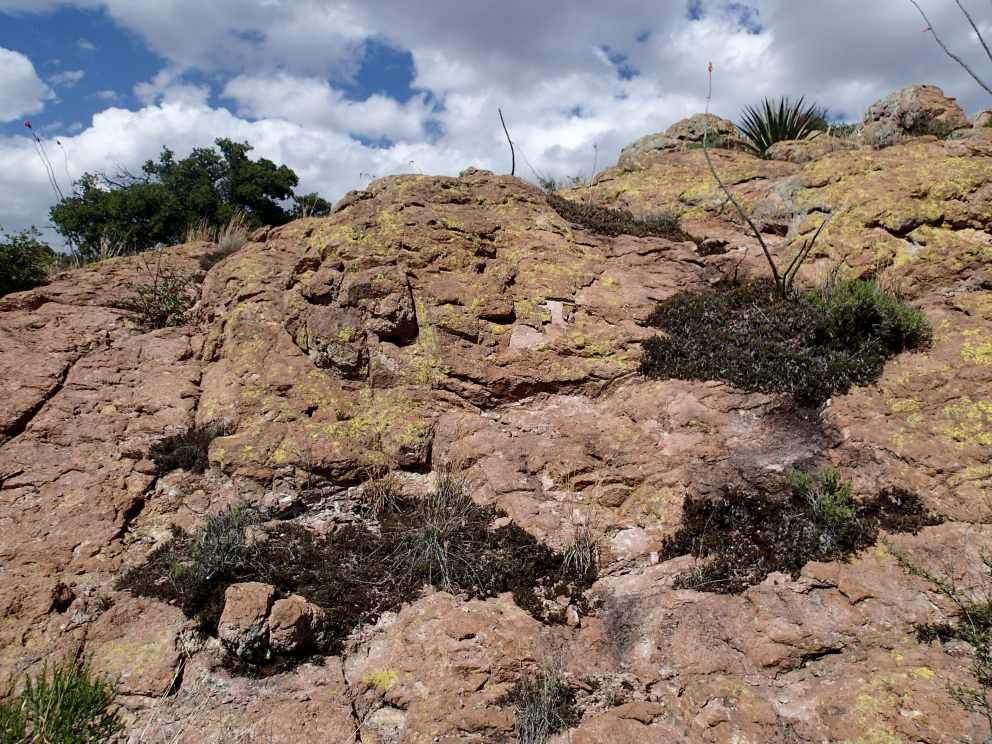This “Notes from the Field” post is from BRIT Biodiversity Explorer Dr. Sula Vanderplank.
Mission: launching Alianca da Terra in Mexico. This blog: a visit to the ranch corridor of Cuenca Los Ojos AC in Mexico.
Participants:
- Lilian Jacinto & Jaime Dias (Alianca da Terra)
- Jose Manuel Perez, Valer Austin, Javier Rivera, & Rafael del Castillo (Cuenca de Los Ojos)
- Enrique Cisneros Tello (Fondo Mexicano)
- Francisco “Paco” Ruiz Ramirez (Serranias Del Burro, Rainmaker Trust)

The group on the US/MX border (Sula is 4th from left).
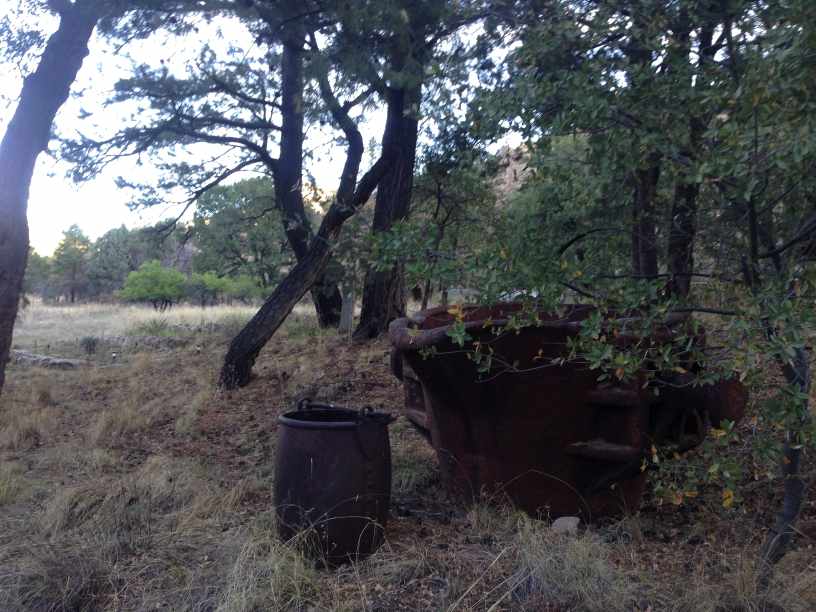
El Coronado Ranch
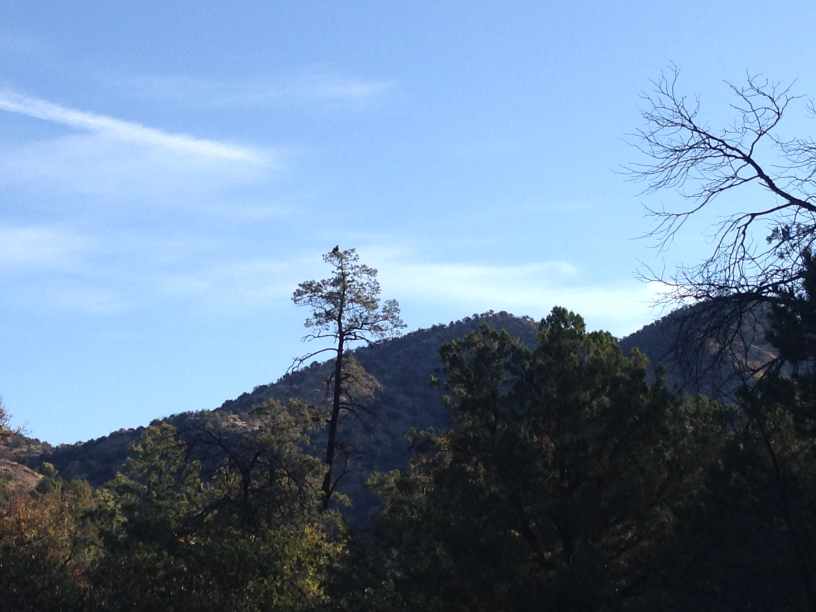
Early morning walk at El Coronado
Day 1. Arriving at the airport I’m met by Jose Manuel Perez of Cuenca Los Ojos and two Brazilian colleagues from Alianca da Terra. We quickly drive out of the city, arriving in the dark to El Coronado Ranch, one of just two Arizona ranches north of the US/MX border that are part of the binational conservation corridor Cuenca Los Ojos (CLO), this one adjacent to Coronado National Forest. I can see that the road is lined with trees, and I’m excited, as it’s been a while since I’ve been in a proper woodland! The ranch house is fabulous, full of fascinating art pieces and details. My dear friend Lilian from Brazil has given me her earrings (which I fell in love with the minute I set eyes on them), and I delighted to head to dinner with my new trophies. Dinner features a fish I have never heard of before – fresh from the Gulf of California – reportedly once rare but now farmed; it is called cazón, and it’s delicious. Leaving the shower my hair is horribly tangled due to sun damage, and I take a moment to reflect on how lucky I am to have a life full of travel and sunshine, where I can’t even seem to look after myself properly. I wince as I pull the brush and decide it’s a small price to pay.
Day 2. From El Coronado to Los Ojos. Awoke to the sound of wild turkeys gobbling. On an early (very early) morning walk we saw badger and deer footprints in the mud and saw herons, turkeys, a red tailed hawk, and blue jays as well as hummingbirds in the woodlands.

Who can it be now?
There are giant junipers here called alligator junipers. There are pinyon pines and 3 species of oak trees. The trincheras or little stone bunkers installed everywhere have done an amazing job of capturing and slowing the passage of water to restore the overgrazed landscape. Once-temporary streams now run all year round, and the landscape is lush and biodiverse. Leaving El Coronado we passed through Barboot Ranch – an area with various earth berms used in the same way as the trincheras. Here they have used a series of chemical treatments for brush control on mesquite, but it is still abundant. The invasive lemon lovegrass (Eragrostis sp.) is still abundant, and the fields are peppered with sotol plants. These are majestic, old-west, open landscapes that stretch as far as the eye can see. The fences have no barbs on the lower wire, since the native antelope (berrendo) always crawl under fences instead of jumping over them. Even in the ranches where antelope are not currently present, CLO is proactively restoring the landscape with the expectation that they will return and roam across these ranches once again.

The international border.
We crossed the international border into Sonora at Agua Prieta and headed toward the Sierra San Luis. Arriving at the Rancho Los Ojos in the afternoon, I am overwhelmed by all the wild flowers – giant golden Aquilegia, stunning red Penstemon, glorious Calochortus lilies, and carpets of arnica (Baileya sp.) and verbenas. There are agaves (A. palmeri), beargrass (Nolina sp.), and sotol (Dasylirion sp.) here – side by side. Meeting the rest of the group was exciting, but I was pensive about the work ahead. Luckily after dinner we had a great meeting where we discussed the criteria for sustainable ranching, and they allowed me to propose two new criteria: biodiversity and habitat quality. I am so excited to have the chance to develop metrics for these amazing ecosystem health indicators and am looking forward to tomorrow.

Calochortus lily

Aquilegia

arnicas and verbenas

More border.
Previous
Next
Dia 3. Las Anitas. In the morning we reviewed the general details of the ranch in a group, then we set out to first see the area that had been historically severely over-grazed and then left fallow for 10 years. The recovery was very interesting; the area had previously been native grassland, but as a result of over-grazing, it was now a shrubland of mesquite (Prosopis glandulosa), creosote bush (Larrea tridentata), and saltbush (Atriplex canescens) with bare ground in between and barely a grass in sight. This area was adjacent to the US/MX border, which was a surprising sight. There was some evidence of people moving through the area (trash, clothes, bottles), but no paths, and the vegetation was so continuous it seemed a very strange place for an international border. In the afternoon we visited various restoration sites on the same ranch. It was absolutely fascinating to see the recovery of the native grasslands. In some areas, the simple process of slowing down the water had resulted in significant improvements in grass cover. In other areas a Lawson Aerator (a rotating drum with blades and some native grass seed) had had an amazing effect. We visited areas with 1 year of recovery and 5 years of recovery, and in both cases the quality of the forage was impressive. We passed through an area with a lot of pottery chards, remnants from the Apache people that once lived here. Some have beautiful patterns and are reported to be up to 500 years old. Towards the end of the day we headed back to Rancho Los Ojos, and on the way we saw wild peccaries (a big and exciting first for me) as well as several deer as the light faded. The moon and Venus lit our path to dinner, and we ate delicious chiles rellenos before returning to fill out the ranch evaluation sheet.



Dia 4. San Bernardino. My two new criteria for a sustainable ranch became four last night (Biodiversity, Habitat Quality, Restoration, and Forage Quality), and today I have a fifth – Water Conservation and drought tolerant crops, not such an issue in the rainforests of Brazil, but definitely an issue here. It came to me while we were visiting the pistachio plantation… a drought-hardy orchard proving difficult to make commercially viable as an organic crop. Nearby there is a new plantation of sotol, propagated from local stock and seedlings being started under clumps of yucca leaves. We visit an old Mormon homestead (rumored to have had bedrooms both sides of the border since polygamy was illegal in the United States), and there is a lot of evidence of over-grazing in the vegetation. Rancho San Bernardino has fewer flowers, but it is fascinating. We first visit Silver Creek where the property line follows the US/MX border. There have been enormous investments in water conservation here, some of which resulted in flooding in the United States. The restoration efforts on this creek are all part of a giant push to restore the cienega, which we had the pleasure of visiting in the afternoon, full of ducks and bullrushes. Despite some damage from Hurricane Odile, the cool clear water flows freely and lush vegetation abounds in the middle of the Chihauhuan Desert.

Silver Creek

Silver Creek

Messing about in the cienega with Flat Bella

The cienega
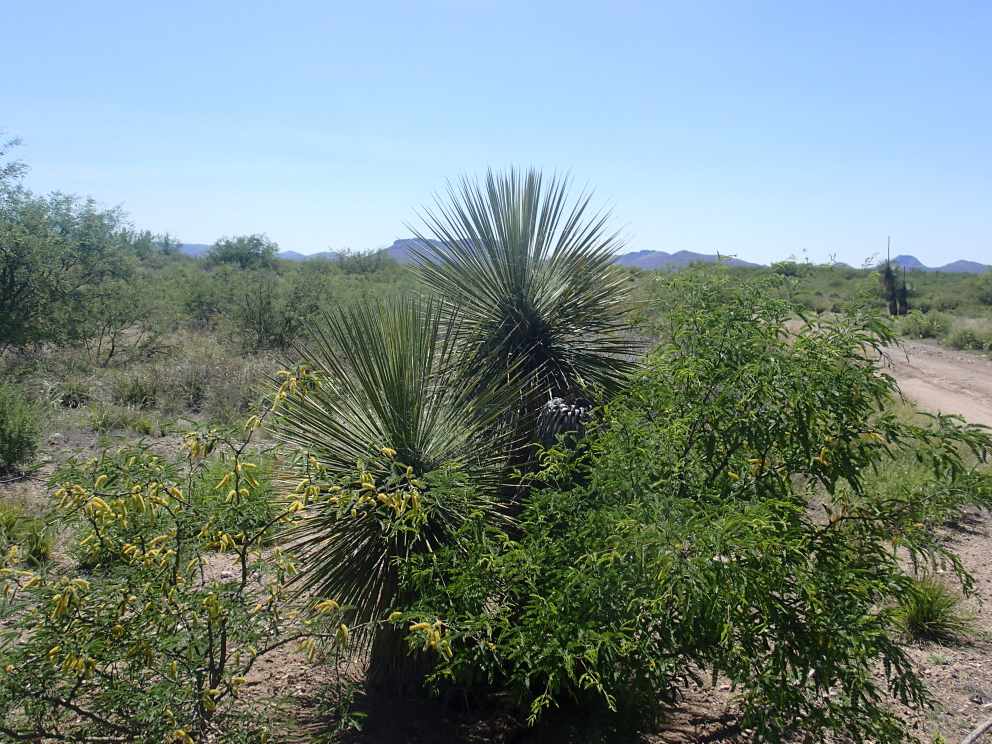

Gila topminnows
There are endemic fish here – Gila topminnows (Peopsilopsis occidentales sonorensis) – and even a tiny area with a little endemic crustacean. A tree here appears to be over 300 years old, and I am overwhelmed by the amount of water and the obvious force with which it has carved through this landscape historically. There are footprints of various mammals in the mud, and I wish we had more time to poke around under the willows and see who else lives here. In the afternoon we visited the schoolhouse/library/museum at the Ranch, and I spent hours reading books on the desert grasslands and the local flora and resource management studies of the borderlands. It was here that I learned of the narrowly endemic white-sided hare that is well known from this region. I also discovered that the continent’s most endangered snake – the scale-nosed rattlesnake (Crotalus willardi) – is known from the adjacent mountains, and I wonder if we might find it here.
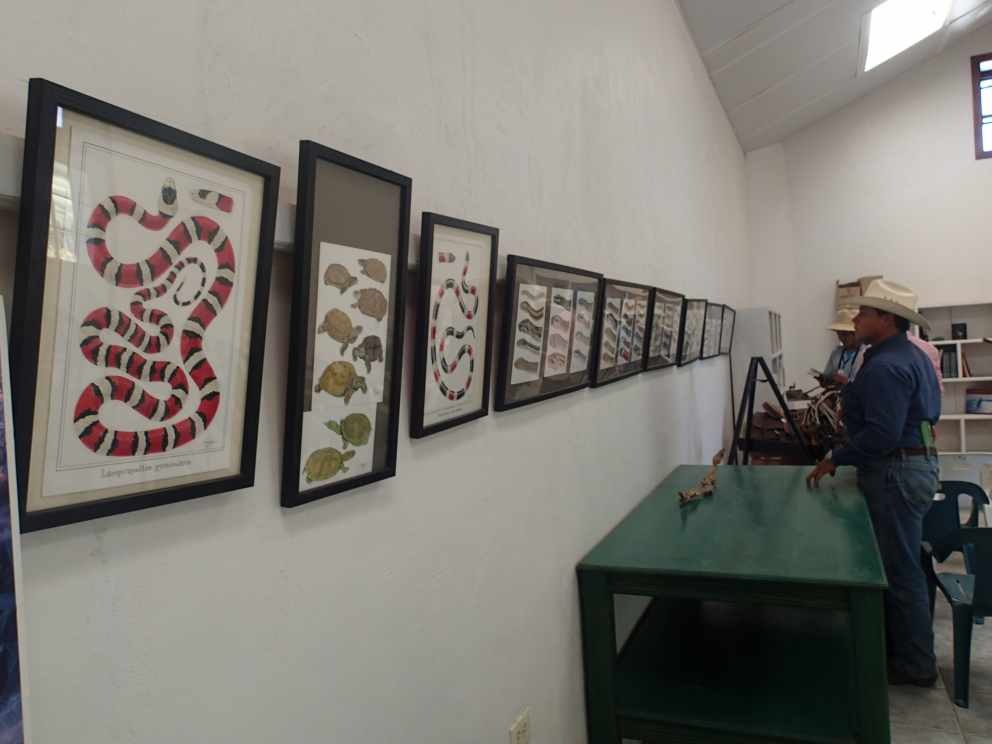
Paco and the schoolhouse.

Lilian and her soil-testing kit.
We ate a cake that was baked in a solar pan while we waited. Impressive technology! On the way home we saw more deer, including mule deer, and a giant rattlesnake, although it wasn’t the rare one. Tonight I have decided to imbibe less sotol, sing less Mexican classics, and go to bed earlier.

Solar cooker cakes!

A jaunty little ocotillo fence.

Jaime and Jose Manuel.
Dia 5. Puerta Blanca. Last night we still worked until around 10:30 pm. Breakfast each day is at 6:30 am, and it’s still cold when we pull out of the ranch at 7:00. Today we visit Puerta Blanca, another ranch on the border. We found two separate smuggler look-out posts, both littered with trash and a sign of the hidden life constantly present along the US/MX border. In their efforts to combat illegal trafficking, the Mexican army has been camped out at this ranch for the last two months. The international border here is just a barbed wire fence, with a recently restored border monument. Although I have heard often of these realities, it is the first time I see it with my own eyes.
Above the buildings on the peñas outcrops is a vegetation community that I love. Agaves, sotols, junipers, cacti, and a suite of wildflowers. Apparently this is also the home of the continent’s rarest snake, but it was very windy and a little chilly, and I was fairly focused on not falling into anything spiny and thus didn’t see any snakes. I am happy scampering on the rocks and looking out at the extensive valley below. This ranch is large but has little vehicular access.


Ferns
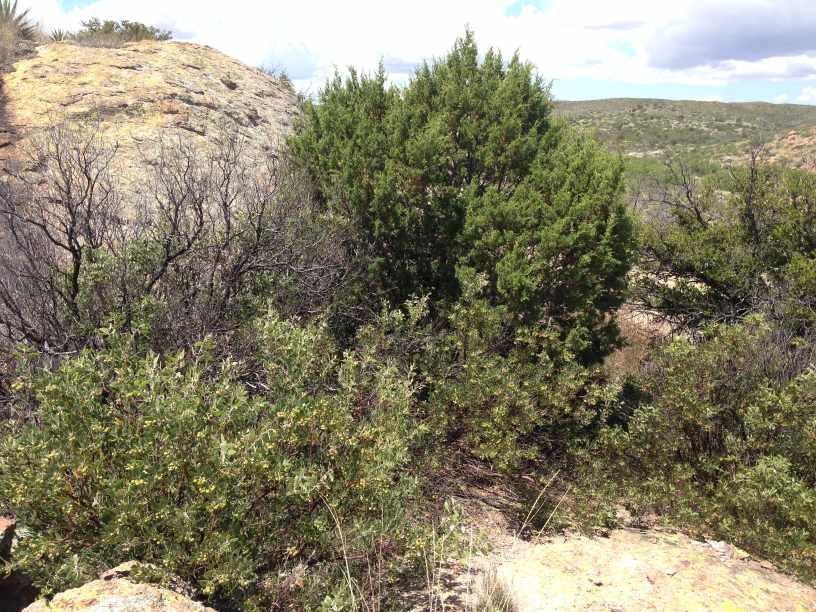

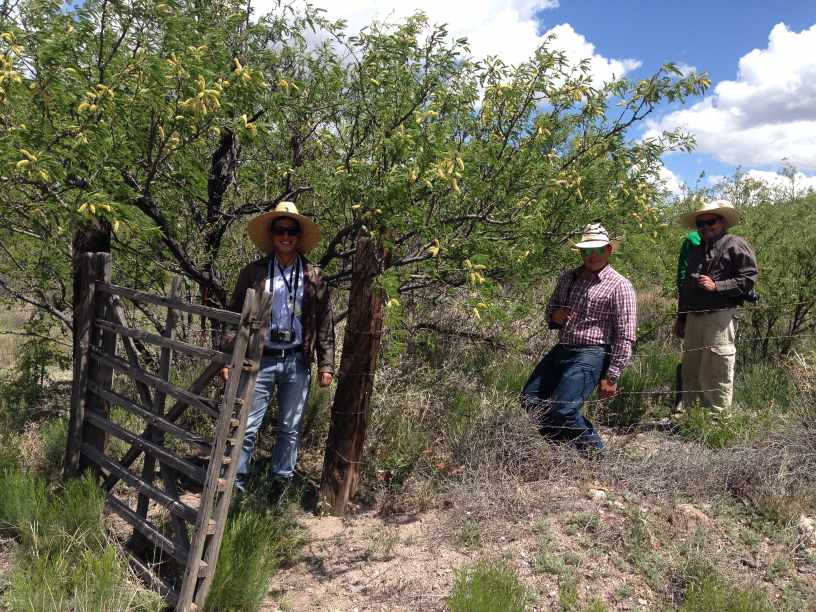
Mighty border fence!


Border monument and us.

Border monument
We have a long meeting with some local ejidatarios and local wildlife biologist Rodrigo Sierra Corona, discussing at length the launch of Alianca da Terra in Mexico, and then we head out together (all in one truck) on a long drive through the higher elevations. The views are stunning, and one of our group even stumbles across a gila monster (which I was heart-broken to miss!).

Gila monster. Photo from Francisco Ruiz Ramirez.
Suddenly it starts to rain. We are ill-prepared at best and have seven people in the back of the pick-up truck. No-one has brought extra clothing, and my sunglasses are little use as the light disappears and the sky fills with black clouds. As night falls we go in search of the rare endemic white-sided hare on the plains of Rancho Los Ojos… in the rain! Unsurprisingly, we don’t see any, but I’m delighted to see their habitat, and these open flat grasslands that have been left fallow and have had no brush control are inspiring. I can’t help but wonder if all these ranch restoration efforts in the region will work wonders for the hare. The long drive back to the ranch is lit tonight with lightning bolts, and at dinner a lovely big moth lands on my tummy and reminds me of being a little girl and hanging out a white sheet with a bright light shining on it, so that moths would come and my dad and I could try to identify them. I’m told that, God willing, we can ride horses tomorrow.




Dia 6. Agua en el desierto.
Giant horse. Riding down the river through clear water. Crossing the river again and again. Hurricanes, fallen trees, not like it used to be. Going to reintroduce beavers here. Nature’s church at the waterfall – incredibly beautiful. Water in the desert.


Ferns, mosses, liverworts, giant golden aquilegias. Later a whole pack of coatis (chulos) and bear scat. Fabulous habitat, like riding through the Old West. Was once part of the Camino Real and before that a well-used horse-trail.
I think of the number of cowboys that must have rested at this waterfall and wondered what percentage gave thanks for this beautiful spot. Rancho El Diablo is a little piece of heaven, and I wish it was mine. Francisco and Alma are great hosts. We return to the ranch early and visit the hot springs. Singing in the hot springs was soul-filling, and in the hot shower from the spring I found two cactus spines embedded in my tummy! The evening meal was a bbq and feast with dancing and Brazilian music. We were joined by legendary lady-rancher Valer Austin herself, and we were falling over ourselves to tell her how much we loved her land and how excited we are about the launch of this new initiative for Mexico. We talked late into the night about next steps, and I slept more soundly than I have in years. In the morning we said our goodbyes, and we headed out at first light. I am looking forward to working with my new friends and helping to improve the sustainability of food production in my beloved Mexico, and I know that together, we can create a network of conservation ranches across Mexico’s biodiversity hotspots and beyond.

